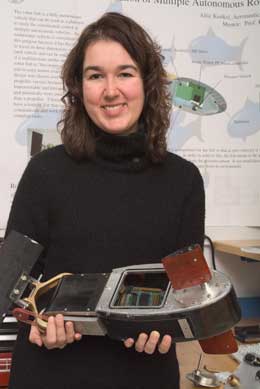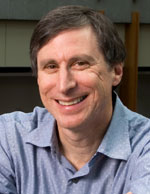UW leading $7.5 million federal study
How do animals on the wing sense and dodge obstacles? Findings may improve autonomous aerial vehicles.

Kristi Morgansen's research team developed groups of robofish to signal each other underwater and swim together. Now she turns her attention skyward.
The Office of Naval Research recently awarded a five-year, $7.5 million grant to a multi-university consortium led by the UW. The research teams will study how birds, insects, and bats sense their surroundings and use that information to control their movement. The teams will also look at balancing short-term navigation, such as avoiding obstacles or countering gusts of wind, with long-term goals, such as reaching a final destination. Findings could guide development of autonomous aerial vehicles that can adapt to obstacles and fly in unpredictable conditions — such as zooming through dense forests or landing on moving objects.
"Biological systems have very simple sensors, but lots of them. How do they use them? Is this something we can leverage for engineered systems?" asks principal investigator Kristi Morgansen, associate professor of aeronautics and astronautics. "We’re trying to make autonomous vehicles more effective at operating in cluttered or low-light environments, or around other moving objects."
In the future, a flying vehicle operated without human direction could be smaller, lighter, and have faster response times. A truly autonomous vehicle would also be cheaper to operate and easier to deploy quickly in situations such as disaster relief.
The multi-institutional team includes researchers at the UW, Boston University, the University of Maryland, and the University of North Carolina at Chapel Hill. The UW's share of the grant is $1.96 million. Tom Daniel, a UW professor of biology, is also involved in the research. This summer the UW will host a national workshop on bio-inspired engineering with a focus on flight.
MORE »
NAE Honors Hank Levy
UW Engineering's newest member of the National Academy of Engineering is Hank Levy, who holds the Wissner-Slivka Chair of Computer Science & Engineering and has been department chair since 2006. He was among 68 new members and nine foreign associates elected this year for the highest professional distinction accorded an engineer. He joins an elite group of eight other active NAE members at the UW. Dean Matt O’Donnell and CSE colleagues surprised Levy with the news at what he thought was an "emergency" meeting.

NAE honored Levy for his contributions to design, implementation, and evaluation of operating and distributed systems, and processor architectures.
Levy has authored two books and over 100 papers on computer systems design, and has supervised 23 doctoral students and 17 master’s students. He has also co-founded two companies, Performant, and Skytap, and serves on the advisory boards of Isilon Systems, Zillow.com, Corensic and Madrona Venture Group.
Four Engineering Faculty Named UW Entrepreneurial Fellows
A new faculty fellows program honors the UW's eight most entrepreneurial researchers — four from Engineering: Oren Etzioni (CSE), Vikram Jandhyala (EE), Yoky Matsuoka (CSE), and Buddy Ratner (ChemE, BioE). The program recognizes commitment to commercializing innovations for societal benefit.
MORE »
More UW Engineering News Online
UW Engineers Help Assess Risks in Wake of Japan Disasters
Controlling a Single Molecule's Reaction with Light Could Improve Solar Cells
Engineers used nanotechnology to control and observe how molecules react when excited by ultraviolet light.
High Dose of Oxygen Enhances Natural Cancer Treatment
UW and WSU researchers have found that an environment of pure oxygen at high pressure significantly increases the cancer cell-killing effectiveness of artimisinin, a compound isolated from wormwood.